2009 Model Year Preview Part 2 (H to M)
Note: Part 1 of this article, from A through F, can be found here.
Part 3 of this article, from N through V, can be found here.
Our series previewing the 2009 model year continues today, starting with letter H – Honda. The this preview includes all vehicles that are new or significantly changed for the 2009 model year, including any early 2009 models already on the market.
Honda
Honda as an automaker generally tends to have a pretty steady product cadence. They don’t blitz the market with a series of new models one year, only to have almost no new products the next year. Instead, most of the lineup is on about a six-year redesign cycle, and the current life cycles are fairly well spaced out. In the past few years, we’ve seen the Odyssey (2005), Ridgeline (2006), Civic (2006), CR-V (2007), and Accord (2008) redesigned or introduced. For the 2009 model year, it’s the Pilot midsize crossover’s turn.
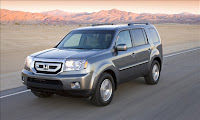 The all-new 2009 Pilot, although still a very conservative shape as the first generation (sold from the 2003 through 2008 model years), is just a different conservative shape. The new model actually is even boxier in appearance than the old model. Frankly, I think Honda really dropped the ball with the Pilot’s redesign. The old model sold well in spite of its looks, and it appears that the new one will have to do the same thing. The grille is particularly unsuccessful, but the rest of the vehicle is strikingly reminiscent of a Jeep Liberty.
The all-new 2009 Pilot, although still a very conservative shape as the first generation (sold from the 2003 through 2008 model years), is just a different conservative shape. The new model actually is even boxier in appearance than the old model. Frankly, I think Honda really dropped the ball with the Pilot’s redesign. The old model sold well in spite of its looks, and it appears that the new one will have to do the same thing. The grille is particularly unsuccessful, but the rest of the vehicle is strikingly reminiscent of a Jeep Liberty.
Inside, however, is a different story, with additional passenger space, comfort features, and technology. The Pilot also gets more power and torque, and slightly better fuel economy. It’s hitting dealers right now.
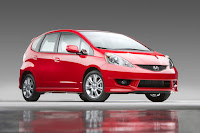 The other big news from Honda is actually small – the very popular Fit subcompact is all-new for 2009. The Fit has only been sold in the US since the 2007 model year and – thanks to high fuel prices and its reputation as a fun-to-drive, flexible little car – has exceeded Honda’s sales expectations. The new 2009 model adds a bit more passenger space and interior flexibility, some additional technology such as an integrated navigation system, and by all accounts, maintains the handling prowess and fuel economy of the old model. Also, while the appearance is definitely evolutionary rather than revolutionary, I greatly prefer the design of the 2009 model, which has a more attractive headlight design, as well as a better looking D-pillar shape, and better proportions thanks to its slightly wider track.
The other big news from Honda is actually small – the very popular Fit subcompact is all-new for 2009. The Fit has only been sold in the US since the 2007 model year and – thanks to high fuel prices and its reputation as a fun-to-drive, flexible little car – has exceeded Honda’s sales expectations. The new 2009 model adds a bit more passenger space and interior flexibility, some additional technology such as an integrated navigation system, and by all accounts, maintains the handling prowess and fuel economy of the old model. Also, while the appearance is definitely evolutionary rather than revolutionary, I greatly prefer the design of the 2009 model, which has a more attractive headlight design, as well as a better looking D-pillar shape, and better proportions thanks to its slightly wider track.
Hummer
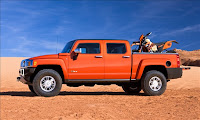 It’s a slow news year for Hummer, the brand likely to be unloaded by General Motors in the next few months. However, Hummer will press on with the previously announced launch of the H3T four-door pickup, which will combine a four-door cab with a somewhat-functional five-foot bed (the much larger H2 SUT “pickup,” in contrast, offers only a three-foot bed and the ability to allow cargo to enter the cab via an Avalanche-like midgate). Engine choices for the H3T mirror those in the H3 SUV – either an inline five cylinder or a small block V8.
It’s a slow news year for Hummer, the brand likely to be unloaded by General Motors in the next few months. However, Hummer will press on with the previously announced launch of the H3T four-door pickup, which will combine a four-door cab with a somewhat-functional five-foot bed (the much larger H2 SUT “pickup,” in contrast, offers only a three-foot bed and the ability to allow cargo to enter the cab via an Avalanche-like midgate). Engine choices for the H3T mirror those in the H3 SUV – either an inline five cylinder or a small block V8.
Hyundai
Hyundai enters 2009 with a heavily revised Sonata midsize sedan, with most of the work applied to the car’s interior, where it was heavily improved in an effort to match or surpass the competition in a very tough segment. Many reviews have praised the results of the Sonata’s tweaks, which also include two new engines (a four cylinder and a V6), which both offer more power, better fuel economy, and fewer emissions.
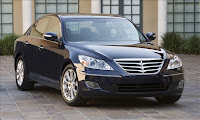 Hyundai’s biggest news, of course, is the launch of its Genesis sedan. As the name implies, the Genesis means a new day for Hyundai, which is selling its first rear wheel drive, V8-powered vehicle in the US. There will be three very competitive engine options – a 3.3 liter V6 (264 horsepower), a 3.8 liter V6 (290 horsepower), and a 4.6 liter V8 (375 horsepower). Hyundai’s intent is to compete with three BMW models at once – the price of a 3-series, the size of a 7-series, and the driving experience of a 5-series. The car certainly has everything it needs on paper, from a ZF six-speed automatic when the V8 is chosen, to adaptive front lighting and adaptive cruise control, to a Lexicon Audio System featuring 17 speakers. Pricing will start around $33,000 for a V6 and at around $38,000 for a V8, which is far below import competition such as the Infiniti M35/45 and Lexus GS350/460, but above domestic competition such as the Chrysler 300C and Pontiac G8. The largest obstacle that Hyundai will have to overcome with the Genesis is that the company made the strategic decision to launch the car without a separate luxury sales channel. That means that the same dealer who has an $11,000 Accent in the showroom will also be hawking very credible, expensive luxury cars. Chevy has a similar issue with the Aveo and Corvette, but the Corvette is more like a bang-for-the-buck sports car rather than a luxury car.
Hyundai’s biggest news, of course, is the launch of its Genesis sedan. As the name implies, the Genesis means a new day for Hyundai, which is selling its first rear wheel drive, V8-powered vehicle in the US. There will be three very competitive engine options – a 3.3 liter V6 (264 horsepower), a 3.8 liter V6 (290 horsepower), and a 4.6 liter V8 (375 horsepower). Hyundai’s intent is to compete with three BMW models at once – the price of a 3-series, the size of a 7-series, and the driving experience of a 5-series. The car certainly has everything it needs on paper, from a ZF six-speed automatic when the V8 is chosen, to adaptive front lighting and adaptive cruise control, to a Lexicon Audio System featuring 17 speakers. Pricing will start around $33,000 for a V6 and at around $38,000 for a V8, which is far below import competition such as the Infiniti M35/45 and Lexus GS350/460, but above domestic competition such as the Chrysler 300C and Pontiac G8. The largest obstacle that Hyundai will have to overcome with the Genesis is that the company made the strategic decision to launch the car without a separate luxury sales channel. That means that the same dealer who has an $11,000 Accent in the showroom will also be hawking very credible, expensive luxury cars. Chevy has a similar issue with the Aveo and Corvette, but the Corvette is more like a bang-for-the-buck sports car rather than a luxury car.
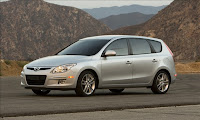 Lastly, Hyundai is launching the Elantra Touring, which is an extension of the Elantra line. The (non-Touring) Elantra was launched for the 2007 model year as a four-door sedan, and the Touring model is basically an all-new body that adds a wagon-like rear end, far more utility and cargo space, and a more attractive (if more derivative) body. Hyundai claims best-in-class interior volume and cargo capacity. Power comes from a 2.0 liter four cylinder shared with the Elantra sedan.
Lastly, Hyundai is launching the Elantra Touring, which is an extension of the Elantra line. The (non-Touring) Elantra was launched for the 2007 model year as a four-door sedan, and the Touring model is basically an all-new body that adds a wagon-like rear end, far more utility and cargo space, and a more attractive (if more derivative) body. Hyundai claims best-in-class interior volume and cargo capacity. Power comes from a 2.0 liter four cylinder shared with the Elantra sedan.
Infiniti
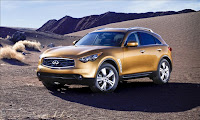 Nissan’s luxury brand, Infiniti, moves into the 2009 model year with just one all-new model – the second generation of the FX on-road SUV. The FX is on sale now, and is available with either a 3.5 liter V6 (FX35) or a new 5.0 liter V8 (FX50). The FX gets an all-new seven-speed automatic transmission with either engine, and gains significantly upgraded interior materials and design, as well as nearly every technology available in cars today (which is appropriate, since the FX is Infiniti’s flagship with the absence of the Q from the lineup). Techno-goodies include the Around View Monitor (also available on the EX35), Intelligent Brake Assist, Distance Control Assist (for heavy traffic), and a hard disc-based navigation system that is coupled with XM’s NavTraffic service.
Nissan’s luxury brand, Infiniti, moves into the 2009 model year with just one all-new model – the second generation of the FX on-road SUV. The FX is on sale now, and is available with either a 3.5 liter V6 (FX35) or a new 5.0 liter V8 (FX50). The FX gets an all-new seven-speed automatic transmission with either engine, and gains significantly upgraded interior materials and design, as well as nearly every technology available in cars today (which is appropriate, since the FX is Infiniti’s flagship with the absence of the Q from the lineup). Techno-goodies include the Around View Monitor (also available on the EX35), Intelligent Brake Assist, Distance Control Assist (for heavy traffic), and a hard disc-based navigation system that is coupled with XM’s NavTraffic service.
Jaguar
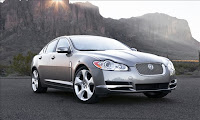 As a brand with a very limited lineup – basically, three models at this point – all-new models for Jaguar only occur once every few years. To that end, the 2009 model year marks the debut of the new Jaguar XF, which replaces the S-type in the brand’s lineup. The XF, in a major departure from tradition, looks very little like Jaguars of the past (while still maintaining several styling cues that hearken back to the 1950s and 1960s), and instead cuts a very modern silhouette, with little of the “Olde English” luxury that marked the brand’s vehicles for much of its history. Jaguar was clearly aware that they had to do something to rejuvenate the brand, as continuing to trot out “all new” models that looked almost identical to the models they were replacing (in spite of more modern chassis and drivetrain components) caused Jaguar sales to slide for the past several years.
As a brand with a very limited lineup – basically, three models at this point – all-new models for Jaguar only occur once every few years. To that end, the 2009 model year marks the debut of the new Jaguar XF, which replaces the S-type in the brand’s lineup. The XF, in a major departure from tradition, looks very little like Jaguars of the past (while still maintaining several styling cues that hearken back to the 1950s and 1960s), and instead cuts a very modern silhouette, with little of the “Olde English” luxury that marked the brand’s vehicles for much of its history. Jaguar was clearly aware that they had to do something to rejuvenate the brand, as continuing to trot out “all new” models that looked almost identical to the models they were replacing (in spite of more modern chassis and drivetrain components) caused Jaguar sales to slide for the past several years.
The XF, which was launched this past spring as an early 2009 model, has already become Jaguar’s best-selling vehicle, and for good reason. The car’s modern shape is perfectly complemented by an interior that combines high-tech lighting, electronics, and modern materials to finally move the Jaguar brand into the 21st century. Buyers of the XF will have the choice of a 300-horsepower 4.2-liter V8 or a 420-horsepower supercharged version of the 4.2 liter V8.
Kia
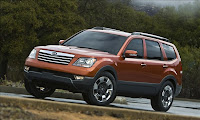 Like the new Ford F-150 and Dodge Ram (or even the 2008 Pontiac G8, for that matter), the Kia Borrego is probably the right vehicle at the wrong time. In a market where midsize body on frame SUVs such as the Chevrolet Trailblazer and Ford Explorer is in freefall, Kia is launching its entry into the segment. The Borrego will offer three-row seating, either V6 or V8 power, and the ability to tow up to 7,000 pounds when properly equipped. Its design isn’t offensive, but it’s also not breaking any new ground. In profile, the D-pillar treatment is reminiscent of the Isuzu Ascender. My best guess for the reason midsize SUV sales have suffered even more than fullsize SUV sales over the past few years is that midsizers offer the same poor fuel economy as the full-size ones, yet less capability. Basically, the folks who truly need an SUV for heavy towing or hauling a large family have continued to buy them, but the “pretenders” (and I was one of them for a few years with a 2005 Pathfinder) have moved onto more practical vehicles such as crossovers, that offer more utility and better fuel economy, at the expense of some offroad capability that probably wouldn’t have been used anyway. The V8 Borrego’s fuel economy numbers haven’t been published yet, but the 4×4 3.8 liter V6 model is rated at 16/21, which tops the 2008 Pathfinder V6 4×4’s and Trailblazer I6 4×4’s 14/20 ratings.
Like the new Ford F-150 and Dodge Ram (or even the 2008 Pontiac G8, for that matter), the Kia Borrego is probably the right vehicle at the wrong time. In a market where midsize body on frame SUVs such as the Chevrolet Trailblazer and Ford Explorer is in freefall, Kia is launching its entry into the segment. The Borrego will offer three-row seating, either V6 or V8 power, and the ability to tow up to 7,000 pounds when properly equipped. Its design isn’t offensive, but it’s also not breaking any new ground. In profile, the D-pillar treatment is reminiscent of the Isuzu Ascender. My best guess for the reason midsize SUV sales have suffered even more than fullsize SUV sales over the past few years is that midsizers offer the same poor fuel economy as the full-size ones, yet less capability. Basically, the folks who truly need an SUV for heavy towing or hauling a large family have continued to buy them, but the “pretenders” (and I was one of them for a few years with a 2005 Pathfinder) have moved onto more practical vehicles such as crossovers, that offer more utility and better fuel economy, at the expense of some offroad capability that probably wouldn’t have been used anyway. The V8 Borrego’s fuel economy numbers haven’t been published yet, but the 4×4 3.8 liter V6 model is rated at 16/21, which tops the 2008 Pathfinder V6 4×4’s and Trailblazer I6 4×4’s 14/20 ratings.
Lincoln
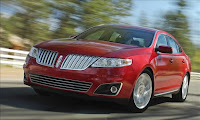 As Lincoln moves to take over the bulk of volume in Ford Motor Company’s Lincoln-Mercury channel, the brand adds a new flagship sedan for the 2009 model year, the MKS. Although the MKS won’t be as large as the antediluvian Town Car (which will continue to soldier on for the next few years, primarily for fleet/livery duty), it’s going to pack far more modern technology and comfort features into its Taurus/Sable/Volvo S80-based platform. All wheel drive will be available (front wheel drive is standard), and power in the first year comes from a 270-horsepower 3.7 liter V6. The MKS, despite its unfortunate name, looks to be a winner for Lincoln so far, with 10,000 pre-orders placed for the car already, prior to its upcoming launch. I sat in the car in Detroit, and it is a very attractive car with a very luxurious, high-quality interior. The interior materials and design reminded me of the 2008 Cadillac CTS, though maybe a half step behind design-wise. The cars compete in different classes, but it appears to be that good.
As Lincoln moves to take over the bulk of volume in Ford Motor Company’s Lincoln-Mercury channel, the brand adds a new flagship sedan for the 2009 model year, the MKS. Although the MKS won’t be as large as the antediluvian Town Car (which will continue to soldier on for the next few years, primarily for fleet/livery duty), it’s going to pack far more modern technology and comfort features into its Taurus/Sable/Volvo S80-based platform. All wheel drive will be available (front wheel drive is standard), and power in the first year comes from a 270-horsepower 3.7 liter V6. The MKS, despite its unfortunate name, looks to be a winner for Lincoln so far, with 10,000 pre-orders placed for the car already, prior to its upcoming launch. I sat in the car in Detroit, and it is a very attractive car with a very luxurious, high-quality interior. The interior materials and design reminded me of the 2008 Cadillac CTS, though maybe a half step behind design-wise. The cars compete in different classes, but it appears to be that good.
Mazda
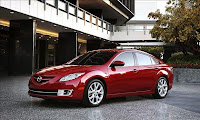 Mazda’s well-regarded but slow-selling Mazda6 midsize sedan is all-new for 2009, and like so many other vehicles, it’s larger, heavier, and more powerful. Instead of residing in the “slightly smaller, lighter, and sportier than the Camry/Accord” niche, the Mazda6 for the US now moves right into the thick of those models’ dimensions. The result is a car that loses its lithe shape and trades it instead for the puffiness that the Camry suffers from. Still, photos of the car show it to be attractive and well-equipped, with a really nice interior. More so than many automakers, Mazda worries about the details and the design, and the new 6 illustrates that with touches such as styled exhaust outlets and a nicely-integrated center stack. Power comes from either a 2.5 liter four cylinder or a 3.7 liter V6 shared with the CX-9 crossover. Other than its inability to hide the extra size externally, the only unfortunate aspect of the new design is the tapered roofline over the rear seat, which is a bit too reminiscent of the Toyota Prius’ roof treatment. Still, if I was in the market for a car in this segment, I’d definitely give the Mazda6 some serious consideration.
Mazda’s well-regarded but slow-selling Mazda6 midsize sedan is all-new for 2009, and like so many other vehicles, it’s larger, heavier, and more powerful. Instead of residing in the “slightly smaller, lighter, and sportier than the Camry/Accord” niche, the Mazda6 for the US now moves right into the thick of those models’ dimensions. The result is a car that loses its lithe shape and trades it instead for the puffiness that the Camry suffers from. Still, photos of the car show it to be attractive and well-equipped, with a really nice interior. More so than many automakers, Mazda worries about the details and the design, and the new 6 illustrates that with touches such as styled exhaust outlets and a nicely-integrated center stack. Power comes from either a 2.5 liter four cylinder or a 3.7 liter V6 shared with the CX-9 crossover. Other than its inability to hide the extra size externally, the only unfortunate aspect of the new design is the tapered roofline over the rear seat, which is a bit too reminiscent of the Toyota Prius’ roof treatment. Still, if I was in the market for a car in this segment, I’d definitely give the Mazda6 some serious consideration.
Mitsubishi
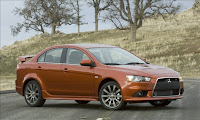 Mitsubishi has had a few rough years in the US market, even having to fight off rumors that the company was going to leave the US altogether. Some well-designed, popular new models have helped reverse the brand’s fortunes to a certain degree, specifically the Outlander small crossover and the Lancer compact sedan. One model missing from the Lancer lineup until the 2009 model year was a model to bridge the gap between the more pedestrian economy-oriented Lancers and the technology-laden (and expensive, and hard-edged) Lancer Evolution. Basically, Mitsubishi lacked a direct competitor to the Subaru WRX, while the Evo competes with the Subaru STi. However, this situation is remedied with the new Lancer Ralliart. The Lancer Ralliart is powered by a 235-horsepower 2.0 liter turbocharged four cylinder, coupled to an all wheel drive system and teamed with Mitsubishi’s twin-clutch transmission. The Ralliart model will not only slot between the Lancer and Lancer Evolution in terms of power and performance, but also in terms of price.
Mitsubishi has had a few rough years in the US market, even having to fight off rumors that the company was going to leave the US altogether. Some well-designed, popular new models have helped reverse the brand’s fortunes to a certain degree, specifically the Outlander small crossover and the Lancer compact sedan. One model missing from the Lancer lineup until the 2009 model year was a model to bridge the gap between the more pedestrian economy-oriented Lancers and the technology-laden (and expensive, and hard-edged) Lancer Evolution. Basically, Mitsubishi lacked a direct competitor to the Subaru WRX, while the Evo competes with the Subaru STi. However, this situation is remedied with the new Lancer Ralliart. The Lancer Ralliart is powered by a 235-horsepower 2.0 liter turbocharged four cylinder, coupled to an all wheel drive system and teamed with Mitsubishi’s twin-clutch transmission. The Ralliart model will not only slot between the Lancer and Lancer Evolution in terms of power and performance, but also in terms of price.
Part 1 – from A (Acura) through F (Ford) can be found here.
Part 3 – from N (Nissan) through V (Volvo) can be found here.




